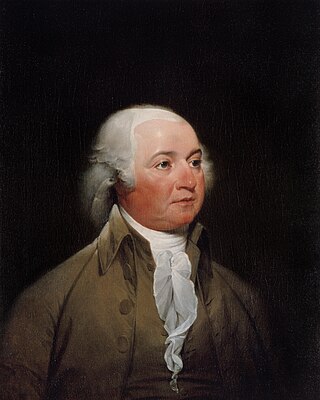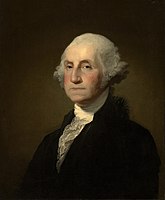
The Twelfth Amendment to the United States Constitution provides the procedure for electing the president and vice president. It replaced the procedure in Article II, Section 1, Clause 3, under which the Electoral College originally functioned. The amendment was proposed by Congress on December 9, 1803, and was ratified by the requisite three-fourths of state legislatures on June 15, 1804. The new rules took effect for the 1804 presidential election and have governed all subsequent presidential elections.

The 1788–89 United States presidential election was the first quadrennial presidential election. It was held from Monday, December 15, 1788, to Wednesday, January 7, 1789, under the new Constitution ratified that same year. George Washington was unanimously elected for the first of his two terms as president and John Adams became the first vice president. This was the only U.S. presidential election that spanned two calendar years without a contingent election and the first national presidential election in American history.

The 1792 United States presidential election was the second quadrennial presidential election. It was held from Friday, November 2, to Wednesday, December 5, 1792. Incumbent President George Washington was elected to a second term by a unanimous vote in the electoral college, while John Adams was re-elected as vice president. Washington was essentially unopposed, but Adams faced a competitive re-election against Governor George Clinton of New York.

The 1796 United States presidential election was the third quadrennial presidential election of the United States. It was held from Friday, November 4 to Wednesday, December 7, 1796. It was the first contested American presidential election, the first presidential election in which political parties played a dominant role, and the only presidential election in which a president and vice president were elected from opposing tickets. Incumbent vice president John Adams of the Federalist Party defeated former secretary of state Thomas Jefferson of the Democratic-Republican Party.
An electoral college is a set of electors who are selected to elect a candidate to particular offices. Often these represent different organizations, political parties or entities, with each organization, political party or entity represented by a particular number of electors or with votes weighted in a particular way.

In the United States, the Electoral College is the group of presidential electors required by the Constitution to form every 4 years for the sole purpose of appointing the president and vice president. Each state appoints electors under the methods described by its legislature, equal in number to its congressional delegation. The federal District of Columbia also has 3 electors under an amendment adopted in 1961. Federal office holders, including senators and representatives, cannot be electors. Of the current 538 electors, an simple majority of 270 or more electoral votes is required to elect the president and vice president. If no candidate achieves a majority there, a contingent election is held by the House of Representatives to elect the president and by the Senate to elect the vice president.

In the politics of the United States, elections are held for government officials at the federal, state, and local levels. At the federal level, the nation's head of state, the president, is elected indirectly by the people of each state, through an Electoral College. Today, these electors almost always vote with the popular vote of their state. All members of the federal legislature, the Congress, are directly elected by the people of each state. There are many elected offices at state level, each state having at least an elective governor and legislature. There are also elected offices at the local level, in counties, cities, towns, townships, boroughs, and villages; as well as for special districts and school districts which may transcend county and municipal boundaries.

The election of the president and the vice president of the United States is an indirect election in which citizens of the United States who are registered to vote in one of the fifty U.S. states or in Washington, D.C., cast ballots not directly for those offices, but instead for members of the Electoral College. These electors then cast direct votes, known as electoral votes, for president, and for vice president. The candidate who receives an absolute majority of electoral votes is then elected to that office. If no candidate receives an absolute majority of the votes for president, the House of Representatives elects the president; likewise if no one receives an absolute majority of the votes for vice president, then the Senate elects the vice president.

The 15th New York State Legislature, consisting of the New York State Senate and the New York State Assembly, met from January 5 to April 12, 1792, during the fifteenth year of George Clinton's governorship, in New York City.

The 16th New York State Legislature, consisting of the New York State Senate and the New York State Assembly, met from November 6, 1792, to March 12, 1793, during the sixteenth year of George Clinton's governorship, in New York City.

The United States elections of 1788–1789 were the first federal elections in the United States following the ratification of the United States Constitution in 1788. In the elections, George Washington was elected as the first president and the members of the 1st United States Congress were selected.

Following is a table of United States presidential elections in New York, ordered by year. Since its admission to statehood in 1788, New York has participated in every U.S. presidential election except the election of 1788–89, when it failed to appoint its allotment of eight electors because of a deadlock in the state legislature.

Following is a table of United States presidential elections in South Carolina, ordered by year. Since its admission to statehood in 1788, South Carolina has participated in every U.S. presidential election except the election of 1864 during the American Civil War, when the state had seceded to join the Confederacy.

The 1792 United States presidential election in Vermont took place between November 2 and December 5, 1792 as part of the 1792 United States presidential election. The state legislature chose four members of the Electoral College, each of whom, under the provisions of the Constitution prior to the passage of the Twelfth Amendment, cast two votes for President.

The 1792 United States presidential election in Connecticut took place between November 2 and December 5, 1792, as part of the 1792 United States presidential election. The state legislature chose nine members of the Electoral College, each of whom, under the provisions of the Constitution prior to the passage of the Twelfth Amendment, cast two votes for President.

The 1792 United States presidential election in Delaware took place between November 2 and December 5, 1792 as part of the 1792 United States presidential election. The state legislature chose three members of the Electoral College, each of whom, under the provisions of the Constitution prior to the passage of the Twelfth Amendment, cast two votes for President.

The 1792 United States presidential election in New Jersey took place between November 2 and December 5, 1792 as part of the 1792 United States presidential election. The state legislature chose seven members of the Electoral College, each of whom, under the provisions of the Constitution prior to the passage of the Twelfth Amendment, cast two votes for President.

The 1792 United States presidential election in South Carolina took place between November 2 and December 5, 1792 as part of the 1792 United States presidential election. The state legislature chose 8 members of the Electoral College, each of whom, under the provisions of the Constitution prior to the passage of the Twelfth Amendment, cast two votes for President.

















